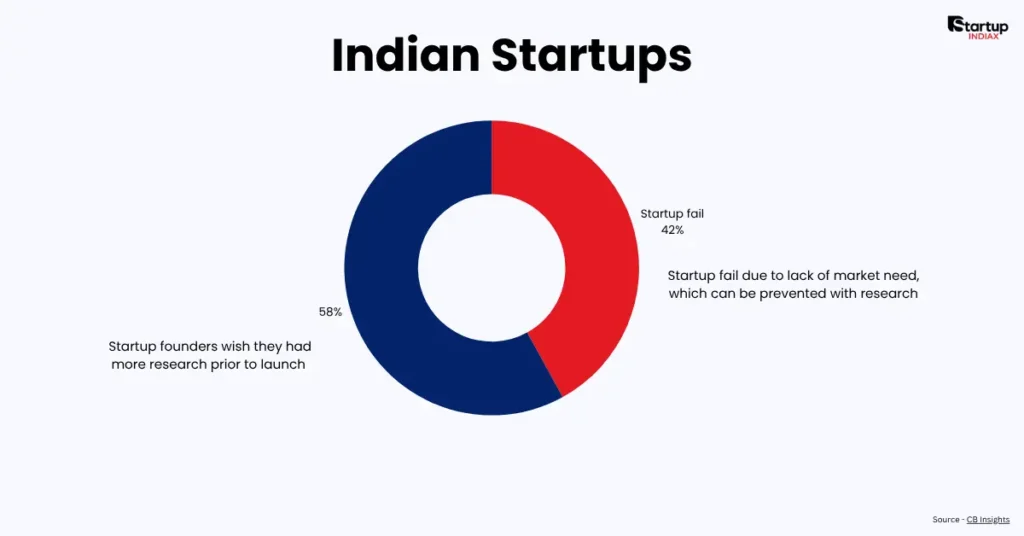Summary
- How to do market research: Learn proven strategies to validate your business idea, understand your audience, and outsmart competitors using data-driven insights.
- Market research empowers Indian startups: Startup INDIAX guides entrepreneurs with practical steps and tools like SEMrush and Google Trends to analyze trends, ensuring informed decisions and sustainable growth.
- Why it matters: This article, published by Startup INDIAX, equips founders and digital professionals with expert-backed methods to reduce risks and boost success in India’s dynamic startup ecosystem.
Introduction
Starting a business in India’s vibrant startup scene is thrilling, but without proper market research, even the most innovative idea can falter. How to do market research is a question every entrepreneur must answer to validate their business idea, understand customer needs, and stay ahead of competitors. In 2025, with India’s digital economy projected to reach $1 trillion by 2030, thorough market research is more critical than ever. This article, brought to you by Startup INDIAX, outlines actionable steps, real-world examples, and top tools to help you conduct market research like a pro.
Why Is Market Research Crucial for Indian Startups?
Market research is the backbone of any successful startup. It helps you understand demand, identify gaps, and avoid costly mistakes. According to a 2023 study by CB Insights, 42% of startups fail due to a lack of market need. In India, where the startup ecosystem is booming—over 100,000 startups were registered by 2024—knowing your market is non-negotiable.

For instance, take AgroStar, an agritech startup that used market research to identify farmers’ need for accessible inputs and advisory services. By understanding their audience’s pain points, they scaled to serve over 1 million farmers. Market research ensures your idea aligns with real-world demand, saving time and resources.
What Are the Steps to Conduct Effective Market Research?
Effective market research follows a structured process. Below, we break it down into actionable steps tailored for Indian entrepreneurs.
How to Define Your Business Idea and Target Audience?
Start by clearly defining your business idea and who it serves. Ask: What problem does my idea solve? Who faces this problem? For example, if you’re launching a fintech app for rural India, your target audience might be tech-savvy farmers aged 25–45.
Use customer personas to map out demographics, behaviors, and pain points. Tools like Facebook Audience Insights can provide data on interests and behaviors. For instance, a persona for your fintech app might reveal that 60% of rural users prefer mobile banking due to limited access to physical banks.
Key Insight: A well-defined audience helps tailor your product and marketing, increasing your chances of success.
How to Analyze Market Size and Growth Potential?
Understanding market size and growth potential validates your idea’s viability. Use reports from MarketsandMarkets or Statista to estimate market value and growth rates. For example, India’s agritech market is valued at $24.1 billion, with a projected CAGR of 25% from 2021–2026. This signals strong demand for tech-driven farming solutions.
To assess growth, analyze trends using Google Trends. If you’re exploring a food delivery startup, check search volume for terms like “online food delivery India” to gauge interest over time. High search volume in tier-2 cities like Jaipur or Lucknow could indicate untapped markets.
Expert Quote: “Market sizing is not just about numbers; it’s about spotting opportunities where demand outpaces supply,” says Ankit Sharma, a startup consultant at Startup INDIAX.
Who Are Your Competitors and How to Study Them?
Competitor analysis reveals what works and where you can differentiate. Identify direct competitors (e.g., Swiggy for food delivery) and indirect competitors (e.g., local restaurants). Use SEMrush to analyze competitors’ keywords, traffic, and backlinks. For instance, if Swiggy ranks for “fast food delivery,” consider targeting long-tail keywords like “healthy food delivery in Bangalore.”
Study competitors’ strengths and weaknesses through customer reviews on platforms like Google My Business. A competitor with slow delivery times presents an opportunity to emphasize speed in your service.
Real-Life Example: Ninjacart disrupted India’s agritech space by analyzing competitors’ supply chain inefficiencies and offering faster logistics, connecting farmers directly to retailers.
What Tools Can Help with Market Research?
Leverage these tools to streamline your research:
- Google Trends: Tracks search trends to identify demand (free).
- SEMrush: Analyzes competitors’ keywords and traffic (paid, starts at $129/month).
- SurveyMonkey: Collects customer feedback via surveys (free basic plan).
- Statista: Provides industry reports and statistics (free and paid plans).
- Buzzsumo: Identifies trending content for your niche (paid, starts at $199/month).
These tools offer data-driven insights, saving time and ensuring accuracy. For example, Buzzsumo helped a Bangalore-based edtech startup discover that “online learning platforms” content was shared 10x more than competitors’ posts, guiding their content strategy.
How to Apply Market Research to Your Business Strategy?
Once you’ve gathered data, use it to shape your strategy. Align your product with customer needs, refine your value proposition, and target high-potential markets. For instance, DeHaat used market research to offer farmers credit and advisory services alongside e-commerce, addressing multiple pain points.
Optimize your marketing by focusing on high-traffic keywords identified through SEMrush. If “sustainable farming solutions” has high search volume, create blog content or ads around it. Additionally, test your idea with a minimum viable product (MVP) and gather feedback via SurveyMonkey to iterate quickly.
Key Insight: Market research isn’t a one-time task—revisit it quarterly to stay aligned with trends and customer needs.
What Are Common Market Research Mistakes to Avoid?
Avoid these pitfalls to ensure effective research:
- Ignoring Local Nuances: India’s diverse regions require tailored research. A product for Mumbai may not suit rural Bihar.
- Over-Reliance on Secondary Data: Reports are useful, but primary data (e.g., surveys) provides real customer insights.
- Skipping Competitor Analysis: Underestimating competitors can lead to missed opportunities or copied strategies.
- Not Testing Assumptions: Validate your idea with an MVP to avoid launching a product with no demand.
Expert Tip: “Many startups fail because they assume customers want their product without testing. Always validate with real data,” advises Priya Gupta, a market research expert.
Conclusion and Call to Action
Market research is your roadmap to success in India’s competitive startup landscape. By defining your audience, analyzing market potential, studying competitors, and using the right tools, you can turn your business idea into a thriving venture. Startup INDIAX is here to guide you with insights and stories from India’s top entrepreneurs. Share your market research tips in the comments, explore more startup stories on Startup INDIAX, or subscribe for weekly insights to fuel your entrepreneurial journey!
FAQs
What is market research for a business idea?
Market research involves gathering data on customers, competitors, and market trends to validate and refine a business idea.
How long does market research take for a startup?
It typically takes 2–6 weeks, depending on the complexity of the idea and access to data sources.
What are the best free market research tools?
Google Trends, SurveyMonkey (basic plan), and Facebook Audience Insights are excellent free tools for startups.
Why do startups fail without market research?
Without research, startups may misjudge demand, target the wrong audience, or face unexpected competition, leading to failure.
How often should I conduct market research?
Conduct research before launching and revisit every 3–6 months to adapt to changing market dynamics.

